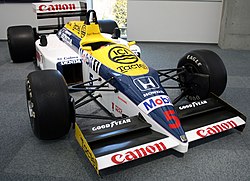Williams FW11
 Nigel Mansell's Williams FW11 (1986).  Nelson Piquet's Williams FW11B (1987). |
|||||||||
| Category | Formula One | ||||||||
|---|---|---|---|---|---|---|---|---|---|
| Constructor | Williams | ||||||||
| Designer(s) |
Patrick Head (Technical Director) Frank Dernie (Chief Designer) |
||||||||
| Predecessor | FW10 | ||||||||
| Successor | FW12 | ||||||||
| Technical specifications | |||||||||
| Chassis | Moulded carbon composite monocoque | ||||||||
| Suspension (front) | Double wishbones, pushrods | ||||||||
| Suspension (rear) | Double wishbones, pullrods | ||||||||
| Axle track |
Front: 1986: 1,803 mm (71.0 in) 1987: 1,778 mm (70.0 in) Rear: 1986: 1,651 mm (65.0 in) 1987: 1,625 mm (64.0 in) |
||||||||
| Wheelbase |
1986: 2,794 mm (110.0 in) 1987: 2,845 mm (112.0 in) |
||||||||
| Engine |
1986: mid-engine, longitudinally mounted, 1,494 cc (91.2 cu in), Honda RA166-E, 60° V6, turbo 1987: mid-engine, longitudinally mounted, 1,494 cc (91.2 cu in), Honda RA167-E, 60° V6, turbo 1987: 4.0 Bar turbo limited |
||||||||
| Transmission | Williams / Hewland 6-speed Manual | ||||||||
| Weight | 540 kg (1,190 lb) | ||||||||
| Fuel | Mobil | ||||||||
| Tyres | Goodyear | ||||||||
| Competition history | |||||||||
| Notable entrants | Canon Williams Honda Team | ||||||||
| Notable drivers | 5. 6. 5. |
||||||||
| Debut | 1986 Brazilian Grand Prix | ||||||||
|
|||||||||
| Constructors' Championships | 2 (1986, 1987) | ||||||||
| Drivers' Championships | 1 (1987, Nelson Piquet) | ||||||||
The Williams FW11 was a Formula One car designed by Patrick Head and Frank Dernie as a serious challenger to McLaren and their MP4/2 car. The car took over from where the FW10 left off at the end of 1985, when that car won the last three races of the season. The FW11's most notable feature was the Honda 1.5 Litre V6 turbo engine, one of the most powerful in F1 at the time producing 800 bhp at 12,000rpm and well over 1,000 bhp in qualifying. Added to the engine's power were the aerodynamics, which were ahead of the MP4/2 and the Lotus 97T. That and its excellent driving pairing of Nelson Piquet and Nigel Mansell made it a force to be reckoned with. The car was an instantly recognisable product of the turbo era of F1.
In 1986, the car won first time out in Brazil with Piquet, before Mansell laid down a title challenge with four wins. Williams were shaken by the near fatal road crash of Frank Williams which demoralised the team. Williams survived the crash but became a quadriplegic as a result, with the 1986 British Grand Prix the first time during the season he would appear in the Williams pits as he went through his rehabilitation. Patrick Head stepped up and managed the team until Williams returned late in the season. This may have caused the in-fighting between the two team mates, and the lost points helped Alain Prost take his second world championship. That and Mansell's spectacular blow out in the final race in Australia where all he had to do was finish third to win the title. The points built up between Piquet and Mansell were enough for Williams to take the constructors' championship, however.
...
Wikipedia
